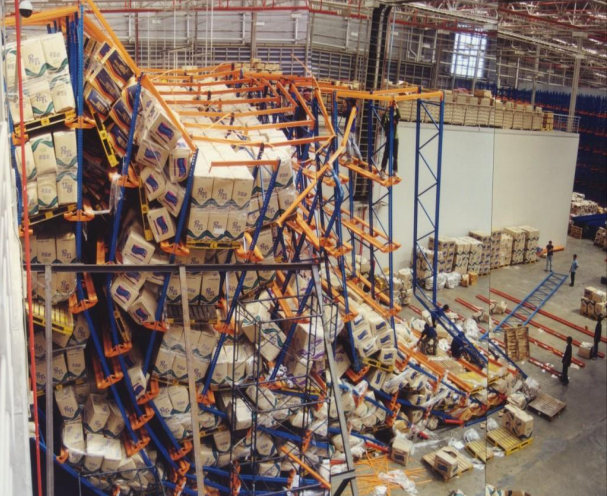Spot The Safety Violation: 10 Rack Safety Tips
This storage rack collapse could easily have injured or killed workers. How could it have been prevented’

In workplaces such as warehouses, distribution centres and manufacturing plants, racks are used to store materials, goods, etc. If used properly, storage racks help keep the workplace clean and organized, and allow for the safe movement of workers and mobile equipment. But if racks aren’t installed and used correctly or properly maintained, they can pose safety hazards.
This picture shows the aftermath of the collapse of very tall storage racks in a warehouse. It’s unclear exactly why they collapsed. But what is clear is that anyone in the vicinity of the racks when they fell down would be in grave danger.
10 RACK SAFETY TIPS
Each jurisdictions’ OHS regulations address the safe storage of materials, including the safe use of storage racks. You should always comply with the specific requirements for racks in your jurisdiction. But Safe Work Manitoba’s Guideline for Industrial Steel Storage Racks recommends these 10 basic rack safety tips:
- When buying storage racks, ensure durability and protection features are built into the design.
- Ensure the structural integrity of the walls and floors before installing your storage rack.
- Install storage racks according to the manufacturer’s specifications. If racks are improperly installed, they can endanger workers.
Example: Pallets of patio doors had been placed in overhead racks in two bays at a home improvement store in Ontario. When a worker opened a bay door, it struck a pallet of patio doors, which tipped over, fell about 11 feet and struck another worker. He suffered serious head injuries. The cause of the incident: the racking system hadn’t been installed properly. The store pleaded guilty to a materials storage violation and was fined $90,000 [Home Depot of Canada Inc., Govt. News Release, July 22, 2014].
4. Ensure the aisles around the storage rack are wide enough to accommodate a lift truck’s turning radius and for the safe operation of powered mobile equipment in general.
5. Conduct regular inspections, maintenance and repairs of storage racks. (Use this checklist to inspect the storage racks in your workplace to ensure that they’re safe.)
6. Look for scratched paint, dents and bowed out components.
7. Ensure you use your storage rack according to the manufacturer’s specifications.
8. Train workers to load storage racks properly. For example, bar workers from overloading racks beyond their safe load limits.
9. Conduct rack safety awareness training for all workers and encourage them to report bangs, dents and any damage to storage racks as soon as is practical’and discipline them appropriately when they don’t.
Example: A forklift operator drove into a rack, seriously damaging it. He didn’t report the incident, which was discovered on the next shift. And he falsified documents to cover it up. He only admitted what happened when confronted him with irrefutable proof. So the employer fired him. And an arbitrator upheld his termination as justified [Winners Merchants Intl LP v. Workers United Canada Council, Local 152, [2013] CanLII 74235 (ON LA), Nov. 25, 2013].
10. Retrain lift truck and power mobile equipment drivers as required to ensure they can safely operate such equipment around storage racks.